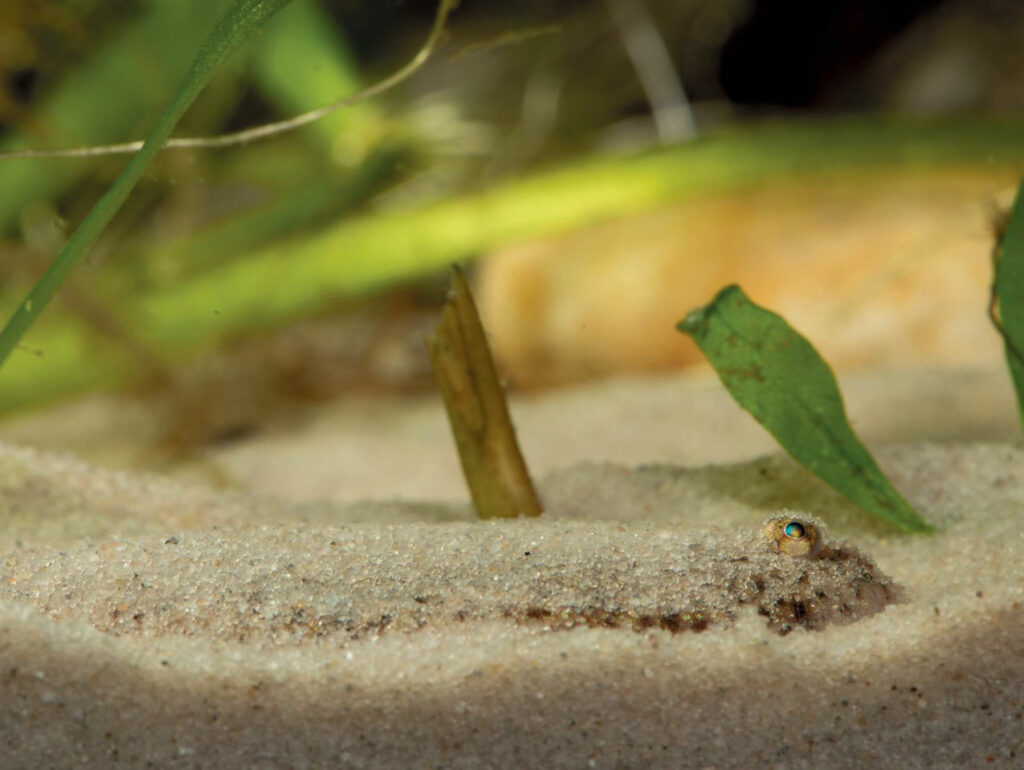
article & images by Stanislav Kislyuk
Fish diversity knows no bounds. Some fish have contrast-rich patterns, while others have fabulous coloration, and some are at the very least simply bizarre in appearance. The bottom-dwelling, asymmetrical freshwater dwarf sole from Malaysia belongs to the last group.
MOST PEOPLE ARE LIKELY FAMILIAR WITH members of the flatfishes (order Pleuronectiformes), especially if they enjoy consuming flounder or halibut. Getting to know them usually begins and ends on a plate in a restaurant, attractively garnished with parsley and a wedge of lemon. By contrast, freshwater soles are more of a mystery. I first encountered them during a vacation trip in Southeast Asia.
Those who want to see freshwater soles for themselves can find these bizarre and mysterious fishes on almost every continent. I decided on a trip to Malaysia, as a particularly small freshwater species, Achiroides leucorhynchos, lives there. This dwarf sole is fairly widespread from Thailand across Malaysia to Indonesia. It grows to a maximum size of about 3.25 inches (8.6 cm), but usually remains significantly smaller. They are euryhaline (tolerant of a wide range of salinity) and occur in marine coastal areas, brackish lagoons, and in soft freshwaters, where they feed mainly on crustaceans and, to a lesser extent, on fishes (Nurhayati and Prianto, 2008).
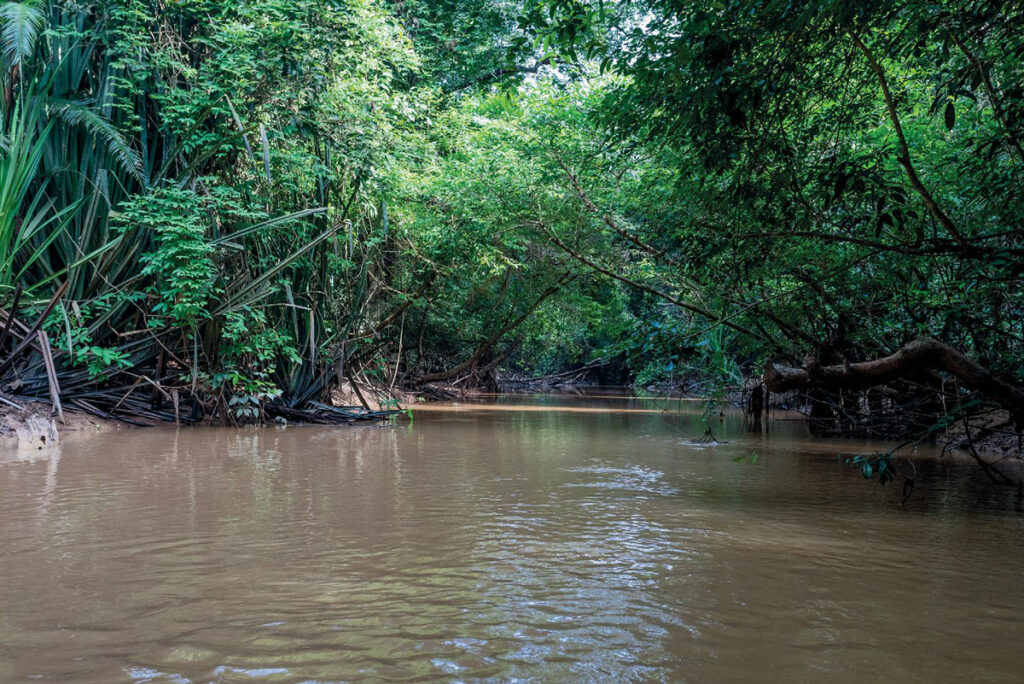
Fishing For Sole
It wasn’t at all surprising that my first acquaintance with this species took place in a freshwater river, locally known and translated as the “River of 100 Fish Species,” in the middle of a Malaysian jungle, a long way inland from the coast. The way to the site was an adventure in itself—a slippery, narrow path that meandered through the lush greenery of the wilderness, interrupted here and there by a fallen tree.
While most of the forest dwellers weren’t to be seen during the day, one type was disproportionately represented: leeches. Upon arriving at the river, we happily plunged into what we thought was safe water—but here, too, the sometimes far-from-small bloodsuckers were waiting for us, specifically in the overhanging vegetation.
With our nets in hand, we first sifted the sandy substrate, covered with a deep layer of leaves, some way away from the bank. It had rained a lot during the previous days, so the visibility in the deep, milky water was anything but good, making it much more difficult for us to fish. Nevertheless, we slowly but surely turned over practically every last little leaf, and thus brought hundreds of leaf-litter-dwellers to light. Two attractive loach species, namely Pangio malayana and P. piperata, as well as the little catfish species Akysis hendricksoni were particularly common there. The extraordinary loaches Vaillantella eupiptera and V. maassi, with their genus-typical, deeply notched caudal fins, proved significantly less common. At one spot, we encountered a fairly large snakehead (Channa sp.), but it managed to free itself from the net with a mighty leap into the air and swam away.
We then fished a shallow sandy area with a depth of just 4–6 inches (10–15 cm) of water, and several small freshwater soles were soon flapping in the net! All were similarly sized at a length of 1.5–2 inches (4–5 cm). There were several dark spots on their sand-colored bodies, creating a camouflage effect. These catches would soon make their way to my home aquarium.
Maintenance Experiences
The freshwater soles that I collected in Malaysia proved to be undemanding in regards to water chemistry. They can be maintained in any water conditions except for extremely acidic or extremely alkaline water. The only important maintenance requirement is a soft, sandy bottom substrate, into which the fish disappear, so that only their eyes are showing while observing the surrounding area.
I initially feared that these flatfish would hide permanently in captivity, but that is not the case. They often assemble right next to the front glass of the aquarium and look hopefully at their keeper in anticipation of a meal. I also see them making short excursions above the bottom, coming to rest again next to a conspecific or sifting through the sand to find something to eat.
Soon, my wild-caught dwarf soles were accepting not only live Tubifex and grindal worms (Enchytraeus buchholzi), but also frozen Artemia. They didn’t seem interested in dry foods. For reasons unknown, feeding my soles with bloodworms turned out to be a mistake, which even led to a loss.
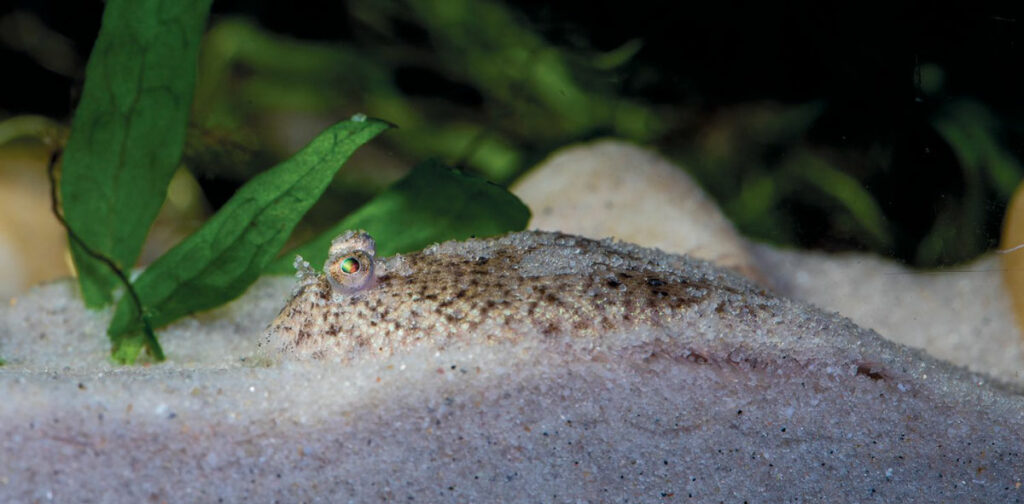
Unfortunately, I know nothing about breeding A. leucorhynchos. Nurhayati and Prianto (2008) carried out a study in the Musi River in southern Sumatra, however, and report that the species probably spawns there in July, during the dry season when the water level is lower, more light reaches the bottom, the water temperature is higher than usual, and the water parameters are stable.
Their small size and manageable swimming-space requirements make these flatfish ideal for maintenance in groups of three to five individuals in aquariums with lengths of 24 inches (60 cm) upwards (volumes greater than or equal to 14 gallons [54 L]). They display no aggressiveness of any sort between individuals, and they are also totally peaceful towards other aquarium inhabitants. No aggressive species should be kept with them, obviously. Achiroides leucorhynchos aren’t exactly the liveliest of fishes. However, if you have some time to spare and want to “slow down” your everyday life, you will certainly find pleasure in these amusing creatures, even though they aren’t eyecatchers at first glance.
Additional Information
Watch our author interview with Stanislav Kislyuk, hosted by Alex Rose.
Reference
Nurhayati, E. and E. Prianto. 2008. Aspek biologi ikan lidah (Achiroides leuchorhinchos) [sic] dan serbaran di sungai Musi, Sumatera selatan. Journal Penelitian Perikanan Indonesia 14 (3): 273–277.

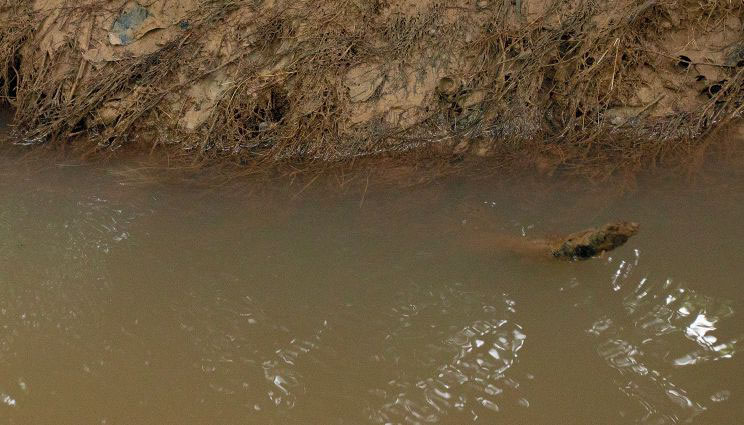
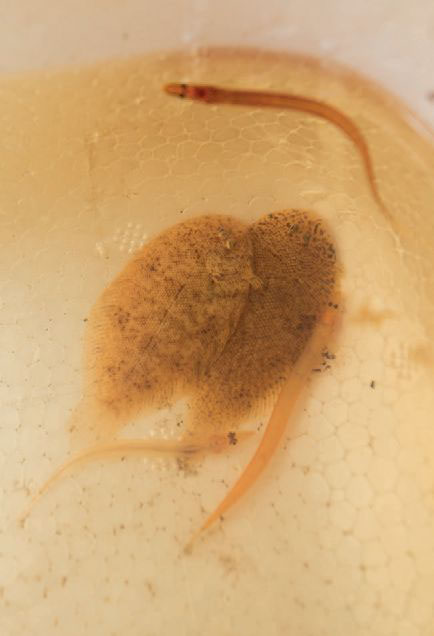





Hi Stanislav Kislyuk, I’m Neil from Sabah Malaysia. Fascinating article on this fish..Can i know which river and what Malaysian state were these sole found in?